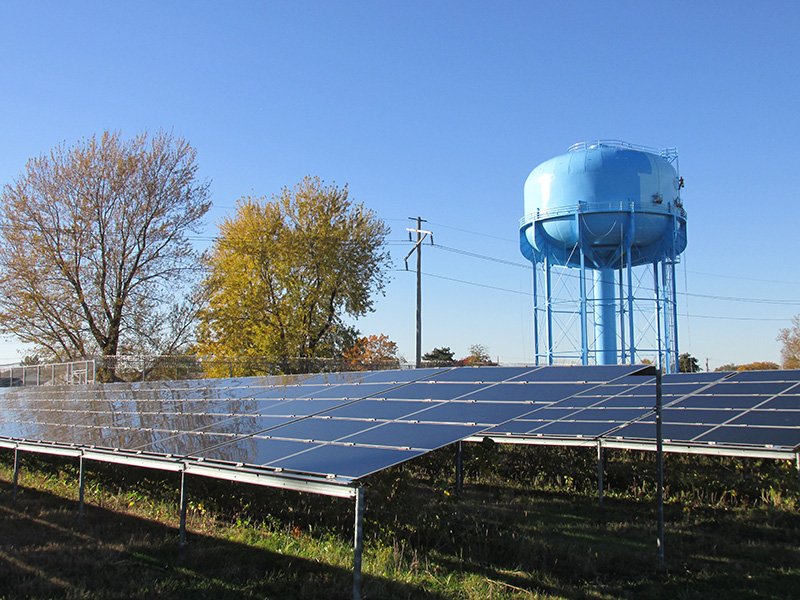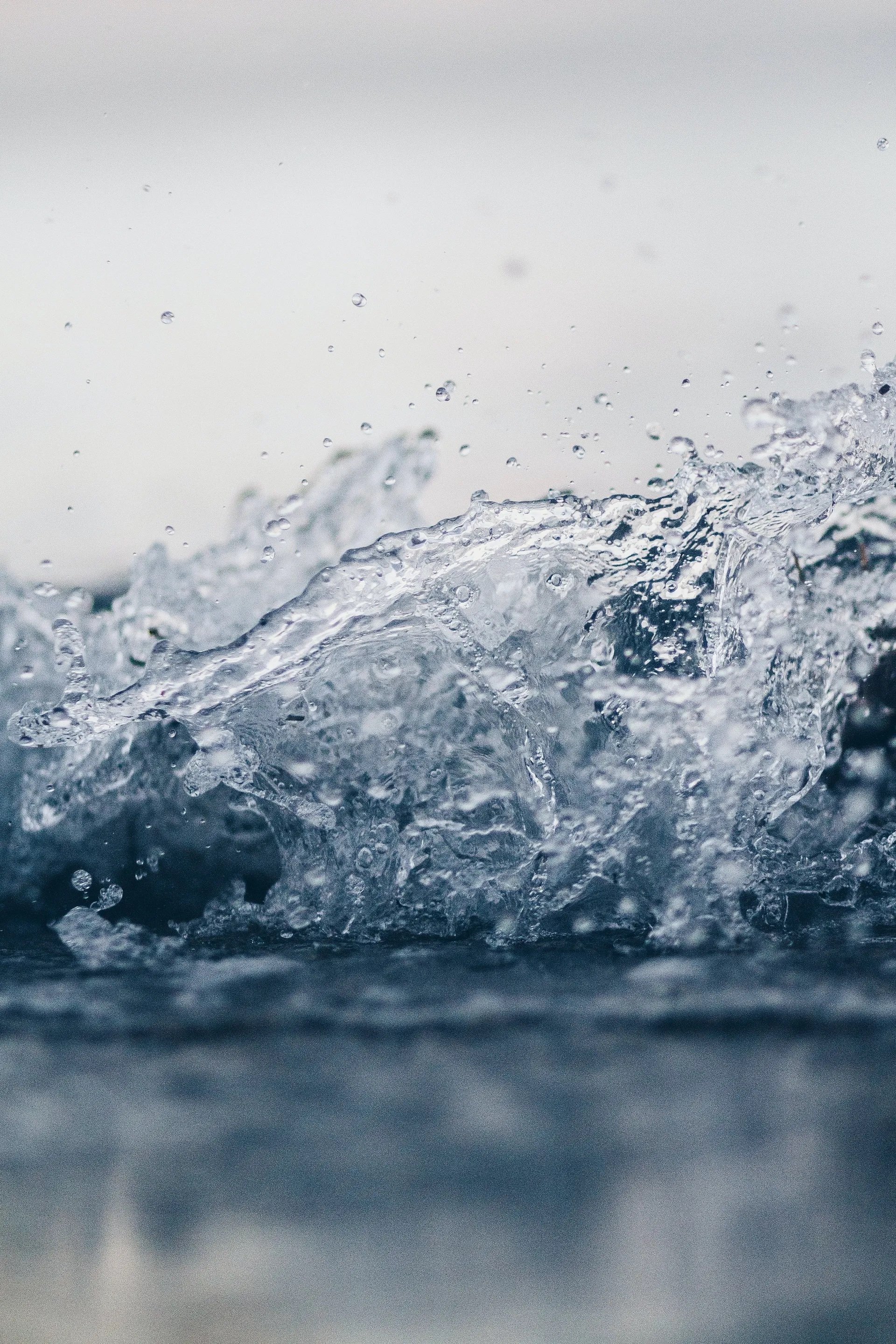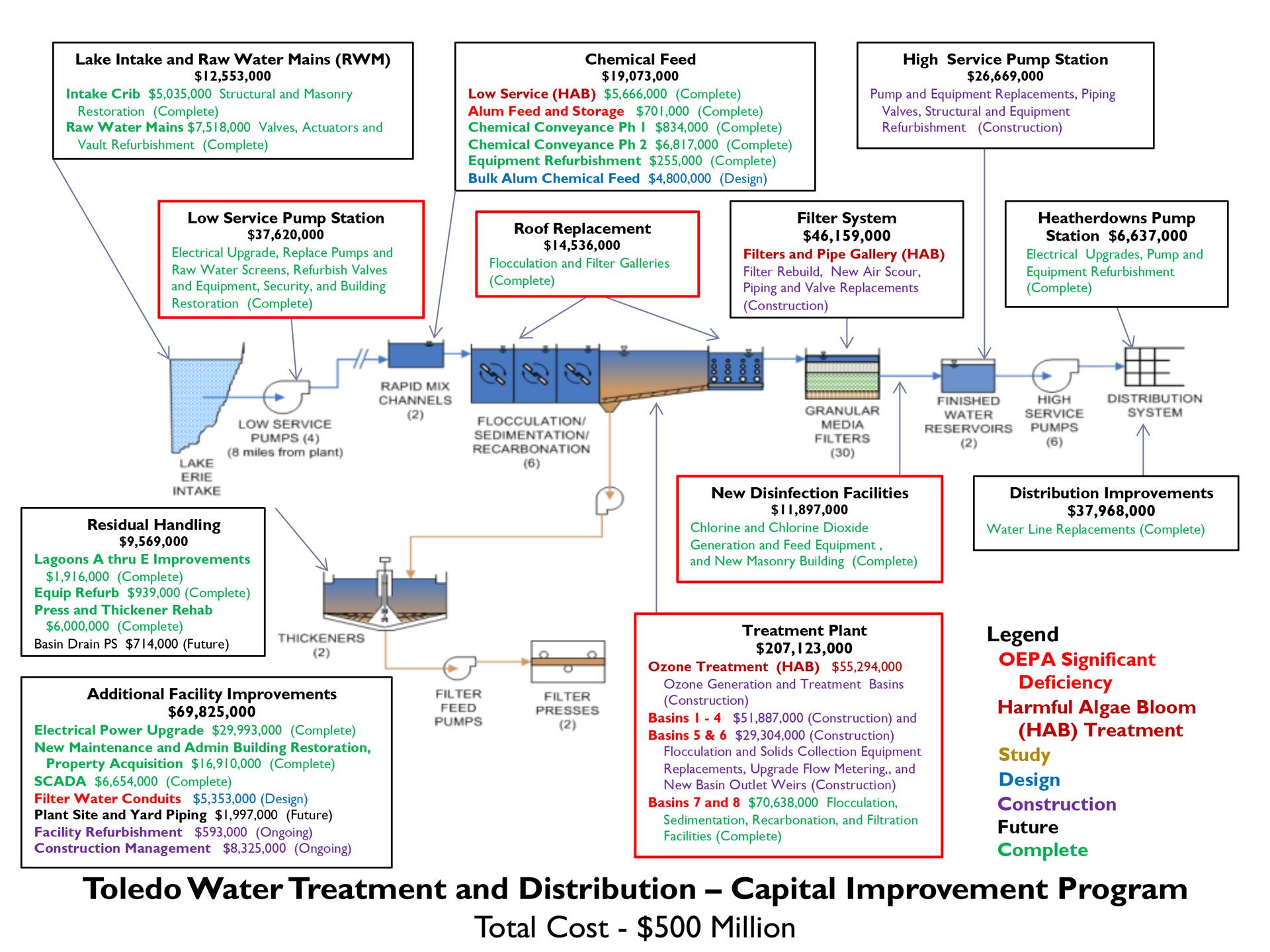
A Watertight Plan
The Plan
Water is essential to our quality of life. From health to nature to commerce, it is vital to our community’s well-being. The City of Toledo is committed to providing an abundant supply of safe, high-quality water for all Toledo-area residents today and for years to come.

What?
The City of Toledo developed a comprehensive plan for both short- and long-term improvements at the Collins Park Water Treatment Plant and other water facilities after conducting a thorough condition and treatment process assessment. This formal Ohio EPA-approved General Plan of Capital Improvements includes renovation of existing infrastructure, construction of new facilities and adding ozone technology at Collins Park as an additional treatment process.
The General Plan includes approximately $500 million in upgrades that have been taking place since 2012 and will continue through mid-year 2023. Some highlights:
Between 2014 and 2015, $5.7 million was spent to improve our ability to treat harmful algal bloom toxins and other organics from our source water in Lake Erie through the quadrupling of chemical treatment capacity and the addition of monitoring devices to provide advance warning of changing lake conditions.
In 2016, $41 million was spent on improving reliability of the water system, replacing the chemical feed system and refurbishing facilities.
Key Projects in the 2017 included a $37.6 million investment in the Low Service Pump Station, where water from the Lake Erie shore is pumped to the plant; a $30 million electrical upgrade at the plant and the start of construction on two new 20-million-gallon basins to provide additional treatment capacity.
In 2018, the city broke ground on the construction of new ozone treatment facilities that will be operational for the 2021 HAB season.
Key projects in 2018 also included upgrade and expansion of the treatment plant maintenance and administration facilities, renovation and refurbishment of the existing solids dewatering facilities and the addition of backup power capabilities at the Heatherdowns Pumping Station.
In 2019, work began to upgrade the East and West treatment plants starting with improvements in Basins 5 and 6 (East Plant) followed by Basins 1 through 4 (West Plant). When completed, both plants will have improved reliability and efficiency of treatment process.
In 2020, major projects include the Filter and Pipe Gallery Improvements and refurbishment of the High Service Pump Station. When finished, these projects will complete the $500 million of programmed capital improvements.
By 2023, Collins Park Water Treatment Plant will be a state-of-the-art facility that will meet the needs of our region for the foreseeable future.
How?
Improved Monitoring and Treatment Systems
Data sondes installed at and near our Lake Erie intake continuously monitor indicators like pH and temperature and provide advance warning of a severe algal bloom. Additional pretreatment facilities (permanganate and powdered activated carbon feed systems) and enhanced chlorine feed capabilities are in place to further protect our drinking water. A second treatment barrier to eliminate harmful algal bloom toxins and other contaminants will be the additional of ozone technology that will be available at Collins Park by July, 2021. Following the ozone project will be the rebuild of existing filters to convert to biologically active filters with sand and granular activated carbon media. The filter improvements will provide the third barrier for treatment of harmful algal toxins at the Collins Park Water Treatment Plant.
Facility Modernization and Upgrades
New equipment and facilities, structural improvements, electrical upgrades and additional capacity are all part of the work at the water treatment plant and its off-site systems. Specific projects include improvements to pumping stations, chemical feed systems, treatment basins, filter systems, instrumentation and controls and plant power supply. As each new project is finished, we are further modernizing the plant and refining operations. When the General Plan of Capital Improvements is fully implemented in 2023, the Collins Park Water Treatment Plant will have the best available treatment technology to ensure the continued reliable production of safe drinking water for our region for many years to come.
Redundant Treatment Capacity
The plan includes constructing two additional treatment basins that will provide 40 million gallons per day of reserve treatment capacity. The new basins will allow the plant to continue to produce an ample supply of high-quality drinking water for all consumers while portions of the plant are taken offline for scheduled upgrades and maintenance.

Why?
The water treatment plant was originally built in 1941, with a major addition in 1956. Throughout the years we’ve updated selected equipment and the facility is structurally sound. However, the General Plan identifies needed improvements and organizes them into an aggressive schedule, enabling the Collins Park Water Treatment Plant to meet even more stringent federal drinking water standards. This program will modernize equipment and update processes, making it a state-of-the-art facility and protecting our investment for future generations.
The cup isn’t half empty or half full. It runneth over.
The main benefit of all this work is the continuous flow of safe, high-quality drinking water delivered through a modern plant, using best available treatment technology. Another benefit of this program is the economic uptick it brings to the area. More than 670 construction jobs are required annually to complete the projects included in the General Plan for Capital Improvements. The plan ultimately helps safeguard Toledo’s health, grows its economy and strengthens its image as a desirable place to live, work and play.
Water rates support the General Plan of Capital Improvements.
Current water rates for Toledo water customers will cover the planned $500 million of capital improvements. In 2020, a new rate structure took effect that will generate sufficient revenues to meet future debt service requirements for the remainder of the planned capital improvements. Concurrently, the city will continue to seek funding sources to keep future water rates as low as possible for all water customers.


